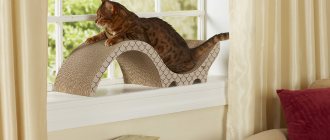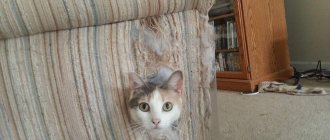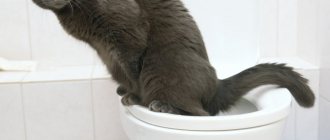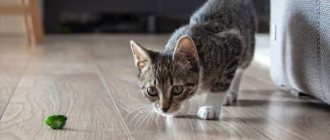Why do cats have a passion for upholstered furniture?
Before you figure out how to stop a cat from tearing up furniture, you need to justify this behavior of your pet to yourself. The animal is partial to upholstered furniture and wallpaper because:
- Follows instincts. Claws are the main defense of cats in the wild. To hunt and survive, they need to hone their claw skills. Now Barsik no longer obtains his own food, but thousands of years of evolution are not easily forgotten.
- Sharpening his claws. People file their nails with a nail file, dogs sharpen their claws while running on a hard surface, and in order for a cat to get their claws in order, they need to stick them as deeply as possible into the hard surface and drag them across it with force. Dead claw scales remain on the upholstery, and new ones form in their place.
- Stretching. You've probably noticed how the purr elegantly arches its back and stretches. At this time, he likes to move his paws, ruining the upholstery.
- Relieves tension. Sometimes a cat kills the sofa upholstery very carefully. She takes out aggression in this way when she is angry or upset.
- Marks territory. Cats have scent pads at the base of their paws. While scratching, the pet marks the object with its individual scent.
When we have decided that it is vital for a fluffy to sharpen its claws, we should consider how to wean a cat from tearing furniture and wallpaper.
Say sharply: “You can’t!”
First, try to influence psychologically. As soon as your cat gets the idea of scratching furniture or walls, loudly and sharply say “No!” or “You can’t!” You can even clap your hands or hiss so that the cat immediately reacts to the sharp sound and changes its mind about doing its job. If you are persistent and notice her intentions in time, then you won’t even need to use our other 6 ideas. If you missed the moment or the method did not work, read on.
Scratching posts
There are many ways to stop a cat from tearing up wallpaper and furniture. The most popular of them is the scratching post
- a special item for scratching claws. They can be horizontal and vertical, floor and wall, in the form of planks and columns. They are united by a soft surface - it is sheathed with thick fabric or wrapped with thick rope.
The easiest way is to accustom a kitten to a scratching post. Place it in a visible place, bring the baby and run your paws over its surface several times. Every time the purr uses an object for its intended purpose, praise it and give it a treat.
In order not to think about how to stop a cat from scratching wallpaper, place the scratching post in a walk-through place: near the sleeping bed, in the play area, next to the sofa. You should purchase several scratching posts for a large apartment.
If a cat destroys the owner's furniture out of spite
This happens very often! The pet will look you in the eye, knowing that you shouldn’t scratch the sofa, but will continue, because he’s doing this out of spite! Why is this happening? Find the cause of dissatisfaction and eliminate it. For example, the animal did not like the food, its tray was not washed, it was not given a treat, it was scolded. Or maybe the cat simply cannot stand the smell of detergent or the owner’s perfume? How to stop a cat from scratching furniture in this case? Monitor your pet's behavior: how he behaves before and after washing the floors, how he reacts to new smells and other people. As soon as the cat starts tearing the furniture, remember what preceded it. You will find the reason quickly, because the animal will show its dissatisfaction as soon as something is not the way it wants!
Anti-scratch
These are special caps for claws made of vinyl. Using glue, they are attached to the cat’s claws, allowing him to express himself without spoiling the interior.
How to stop a cat from tearing up furniture? the anti-scratch pads one by one using glue.
. Every 10-14 days the caps will fall off and need to be re-glued.
At first the animal will try to get rid of the “manicure”, but will soon get used to it. Anti-scratch guards are available on the market in different sizes depending on the length of your pet’s claws (S, M, L). It is advisable to purchase several sizes at once.
Sticky surfaces
How to stop a cat from scratching the sofa? Just let it stick once or twice! Attach double-sided tape to the upholstery. As soon as the animal approaches to scratch its favorite place, it will immediately stick its paw or fur on its side. Cats hate being clingy, so you won't need a lot of lessons.
Place the tape in all places where the cat sticks its claws - the window sill, corners, doors, and so on. Soon the animal will avoid dangerous places three meters away!
Important points
When purchasing a scratching post, add a few drops of valerian or motherwort to it (they attract cats). The scratching post should:
- match the pet’s height;
- be securely fastened and withstand pressure from the animal;
- be of medium degree of hardness and roughness.
When choosing a spray, make sure that it does not cause an allergy in your purr. It is best to have your nails trimmed by a veterinarian at first. If you trim the nail too much, you can damage nearby blood vessels, cause an infection, or at least cause pain to your pet.
If you don’t know how to stop a cat from scratching furniture, don’t forget to use traditional methods:
- say “no” or “no” sharply and loudly;
- lightly spray your pet with water from a spray bottle (this will not harm, but it will be unpleasant for the animal).
How to stop a cat from scratching furniture and wallpaper? Use scents. Felines do not like the smell of citrus fruits, onions and vinegar. Dilute citrus oil with water and spray the liquid onto the damaged areas.
How to stop a cat from scratching furniture and wallpaper
Before a furry pet appears in the house, future owners prepare everything necessary for it - a place to sleep, toys, a tray. But not everyone expects a little kitten to damage furniture and wallpaper until they come face to face with this problem. Although this behavior is absolutely natural for cats.
The Murkosha shelter has accumulated a wealth of experience in adapting pets to new conditions.
Read about the cat’s first steps in a new home here: https://murkosha.ru/nashi-stati/povedenie-koshek/pervye-shagi-koshki-v-novom-dome.
This article contains some tips on how to stop a cat from scratching furniture.
- 1) Why does a cat sharpen its claws?
- 2) The first step is to purchase a scratching post
- 3) Ways to stop scratching furniture
- 4) How to protect furniture and wallpaper
Why does a cat sharpen its claws?
Wild cats, the predecessors of our furry pets, fed themselves by hunting small game. And the hunter’s main weapon is his claws. Predators protected their territories, preventing strangers from entering, and marked the boundaries of their possessions by scratching trees. Claws and tree climbing skills helped the animals survive. Domestic felines inherited hunting genes. So why do cats often damage the interior items of the owner’s apartment?
Before you stop a kitten from scratching property, you need to understand that the cat considers the owner’s house, where the cat lives, to be her own. That is why it marks it with its scent, which is released from the pads on its paws. So she prevents other cats from appearing on “her” territory, warning them with the help of smell that she is occupied. And a pet’s scratching of walls and furniture is not out of spite or whim. This procedure helps her grind down the tips of her claws so that there is no discomfort when walking. Wild cats wear down their claws by moving along the ground and scratching trees. And those at home use what is at hand: a sofa, an armchair, walls, etc. If there is no other, more attractive alternative.
The first step is to purchase a scratching post.
Advice immediately arises on how to wean a cat from scratching furniture - you need to give it something that it can scratch (satisfying a vital need) without irritating the owner. A scratching post was invented specifically for this purpose.
Without training a kitten to use a scratching post, all other ways to stop a kitten from scratching furniture are ineffective. Simply because cats definitely need to sharpen their claws. So, first you need to give the kitten the opportunity to do the right thing (sharpen its claws on a scratching post), accustom it to this, and only then (although in fact it is possible at the same time) correct the incorrect behavior.
Some important tips for successfully training your pet to use a scratching post:
- Place the scratching post near your cat's sleeping area so that she can use it immediately after waking up.
- If you notice your cat's intent on sharpening his claws, move him to the scratching post and run his paws along it, imitating the natural movements of a cat when scratching. After several attempts, the pet will get used to the new device.
- To speed up habituation, you can buy several scratching posts or make them by wrapping a board with sisal rope and place them in different places in the apartment, preferably directly next to the places that the cat likes to scratch.
- You can screw several toy balls from the pet store to the scratching post so that the kitten can play independently.
- Take a feather or other flexible oblong object and invite the kitten to play, gradually leading him to the scratching post, and as soon as you get to it, concentrate the movements of the toy there.
- The upper part of the scratching post, which you need to reach, should be slightly scented with catnip or a weak solution of valerian tincture. Cats will climb to the source of the smell, which will allow them to quickly become accustomed to the object. But do not use this on a kitten - it has too strong an effect on kittens, and instead of getting accustomed to the accessory, the pet will begin to feel afraid of it.
- If the cat begins to approach the scratching post on its own, praise it. If adult cats, like kittens, love to play, then you should concentrate the play next to the accessory, and try to make the animal jump and cling to it.
- During the process of training your pet, it is worth rewarding its diligence with a piece of cat treat to reinforce the result with pleasant emotions. Experienced breeders, in order to accustom a cat, recommend leaving a treat at the top so that it is forced to climb after it.
Read more about training to use a scratching post: https://murkosha.ru/nashi-stati/soderzhanie-i-ukhod/kak-priuchit-kotenka-k-kogtetochke;
https://murkosha.ru/nashi-stati/soderzhanie-i-ukhod/kak-priuchit-vzrosluyu-koshku-k-kogtetochke.
Ways to stop scratching furniture
But you need to understand that the cat will not get used to the scratching post on the first day. Especially if you have already gotten used to tearing things up. Therefore, in parallel with accustoming to a scratching post, you should try several ways to stop a cat from scratching furniture, which experienced volunteers at the Murkosha shelter are ready to suggest.
- To say sharply “you can’t!”
Cat owners know how smart and trainable these animals are, who quickly respond to their name and run when called. Therefore, you can show the cat that you are unhappy with his behavior. As soon as the animal wants to scratch the furniture or wallpaper, you need to say loudly and sharply: “You can’t!” Possible options are to clap your hands or hiss so that the pet reacts to the sharp sound and stops trying. This procedure must be repeated again and again every time the cat wants to put its claws on the furniture. If the owner is persistent and notices the pet’s intention in a timely manner, then correcting habits will be crowned with success already at this stage.
- Scare away with smells
There is an even simpler method to stop your cat from scratching furniture and walls. All members of the cat family have a developed sense of smell. There are smells that cats hate, namely:
- - citrus fruits (orange, grapefruit, lemon);
- — aromas of some spices (coriander, chili pepper, suneli hops);
- - the smells of certain plants (rosemary, lavender, eucalyptus).
To wean a kitten from scratching furniture and scare it away from places where it can do harm, you need to place bags of citrus fruits or spices there or drop a little essential oil on the furniture.
- Spray with water
In order to stop your cat from scratching household utensils, you can use plain water in a spray bottle. Cats do not like water treatments, so you can stop another attempt to sharpen their claws by lightly spraying your pet with a spray bottle. The cat will begin to associate scratching furniture with the unpleasant sensations of water and will stop approaching this place. However, the Murkoshi team recommends using this method with great caution, since there is a risk that the pet will perceive this as aggression. It is better to focus on the first two methods and training to use a scratching post, and leave the spray as a last resort, which can be resorted to only in isolated, exceptional cases. And in this case, it is important to do this only at the moment of scratching, otherwise the cat will associate the unpleasant sensations not with the furniture, but directly with you.
How to protect furniture and wallpaper
Finally, in parallel with working on the cat’s behavior, you can protect things with special means or ensure that damage from claws is minimal.
- Trim the claws
The easiest way. Firstly, you relieve your cat of one of the reasons for sharpening her claws - the need to shed dead layers. Secondly, clipped claws will not cause much damage, even if the pet decides to sharpen them on the sofa. But in this case you need to follow a number of simple rules:
- — you can only use a special nail clipper for cats;
- - during the procedure, the cat should be on the owner’s lap, its paw should be in the person’s left hand, and the scissors should be in the right;
- - cut off no more than a third of the claw, because next is the sensitive area;
- - at the end, be sure to treat your pet with something tasty.
If you do not have experience in carrying out this procedure, the staff of the Murkosha shelter recommend cutting your nails the first few times at a veterinary clinic. Then, watching the actions of a specialist, you can do it yourself.
Please pay special attention: cutting your hair does not mean removing it! It is strictly forbidden to remove a cat's claws! Because the claws are removed only together with the lower phalanges, on which the cat rests when walking. By doing this you will actually make your pet disabled. Just imagine that a person's last phalanges of fingers were cut off. For a cat, declawing is the same. After this, problems with behavior and health arise - cats become more aggressive, and their life expectancy is reduced by 2 or more times. It is no coincidence that in the vast majority of developed countries such an operation is prohibited by law.
- Buy anti-scratch pads
A good way to protect the interior from your pet’s claws are “anti-scratch guards” - silicone overlays on the claws of the cat’s front paws. They are sold in veterinary stores and come in different colors. They are attached with a special glue and fall off after two months with a layer of claws without harm to the animal.
- Organize sticky surfaces
Cats do not like sticky surfaces and will not sharpen their claws on furniture with sticky tape. It is recommended to use double-sided tape or sticky paw tape (available at veterinary pharmacies), which can be attached to any surface.
- Use Kotostop or other protective equipment
You can use protective materials. For example, cover the affected areas on the wallpaper with a temporary shield made of plastic or glass. You can use “Kotostop” - these are flexible protective panels made of transparent plastic that are attached to the wall and reliably protect it from claws. Moreover, such a screen will even be visually almost invisible.
This needs to be combined with training to use a scratching post. Place it next to such a place - the cat will not be able to sharpen its claws where it is used to, but you will give it a very close alternative. Soon he will get used to it and understand that the scratching post is much more convenient.
Thus, in order to wean a cat from scratching furniture and walls, you must first of all give it an alternative - a scratching post. At the same time, you can wean her from scratching using sharp sounds, unpleasant odors for the cat, and water. It is also advisable to trim your cat's claws. Well, furniture, among other things, can be protected with special means like Kotostop.
Limiting your pet's access to things
Hiding damaged areas of furniture
Some elements of an apartment's interior, such as leather furniture, are very attractive to cats, so it is recommended to stick double-sided tape, masking tape with the sticky side up, or special sticky strips on it (sticky surfaces are unpleasant for cats).
Cover furniture with plastic sheeting or rugs. Cats find this texture unpleasant.
You can use protective covers that are easy to wash and clean.
Vandal-proof sofa cover
We close the doors where the pet’s favorite furniture is located.
It's not difficult to keep the door closed and keep pets out of valuable furniture. If a cat sneaks in, make a sharp, loud noise so that it gets scared and runs away.
Remedy to prevent cats from tearing up furniture
Various methods are practiced to wean cats from damaging furniture, but the best solution is a scratcher, which can be of completely different designs. There are wall and floor options, model houses, multi-story buildings for every taste! It is advisable to do this immediately after the kitten appears in the house - this will allow you to immediately accustom your new household member to the correct use of a scratcher and suggest that this is much more interesting than training on furniture. To make it easier to train your pet to sharpen its claws on a special device, you can use smells or treats that are pleasant to the cat.
Which cats don't tear up furniture?
What cats don't tear up furniture? Will breed play a role or not? There are many questions, but in fact, there are no cat breeds whose representatives do not damage furniture. Scratching is a need for all felines without exception. There are no cats with a congenital lack of need for scratching procedures and you need to come to terms with this. It can only be noted that experts identify breeds that are more intelligent and can more easily learn to use a scratching post.
"Velvet paws" or declawing
Declawing is more than just cutting the claws out of an animal's paw. Essentially, this is cutting off fingers. Part of the cat's paw is amputated up to the first joint; this is where the roots of the claws are located.
The operation is performed under general anesthesia. You shouldn't abuse anesthesia unless absolutely necessary, because... even a healthy young body receives a severe shock.
After amputation, stitches and bandages are applied, and you should monitor the cat at home at all times. The animal will try to get rid of the bandages and “lick” the wounds. It is necessary to ensure that the cat does not get an infection or damage its paws; it is better to temporarily discard the litter in the tray.
If the amputation was done incorrectly, after some time the claws may regenerate and try to grow back. But of course it’s not the way nature intended, often inside the foot or in some other unnatural way. This causes severe pain and inflammation, and the amputation must be repeated.
The operation itself is extremely painful, and even when the physical wounds finally heal, the mental ones may never heal.
Cats move like ballerinas, relying on the tips of their paws, that is, their fingers. If you cut them off, the cat’s whole world will turn upside down. The tips of the paws bear the entire weight of the cat's body when walking, running or jumping. This means that without the tips of its paws, the cat will not be able to move freely. Her coordination will be impaired.
After surgery, cats often experience personality changes. Without claws they feel defenseless. Therefore, an affectionate cat can become aggressive, while a completely tame cat can begin to be afraid of everyone and hide. And do not forget that after amputation the animal not only feels, but also becomes completely vulnerable. Claws are the only means of defense and a way to get food. In case of danger, the cat will not be able to hide from the dog in a tree. Instinct will tell her to quickly climb up there, but the injury will lead to the cat simply sliding down the trunk to be torn to pieces by the pack. The cat will never be able to get its own food, it will never be able to feel calm and safe again. Cats with amputated toes cannot be taken to the dacha or released into the street, because... if you accidentally lose such a cat, it will be doomed to death. If you have several cats living with you, a cat without claws will not be able to fight back against its relatives, which will cause its demotion in the hierarchy and severe constant stress and oppression.
Nail trimming
Nail trimming is perhaps the easiest and most effective way to combat scratching. It doesn’t hurt the cat at all, the procedure is very simple, you can trim your cat’s claws yourself in just a minute.
It is worth trimming the claws with special scissors, which are sold at the pet store.
“Squeeze out” the claw and cut off the hook from bottom to top. Only the narrowest part of the claw should be cut off. We cut carefully so as not to touch the blood vessels.
If the animal’s claws are dark and the blood vessels are not easily visible, you need to cut the claws very carefully, literally 1-2 mm at a time and then with a special nail file (you can also buy it at a pet store).
You can trim your nails as they grow, usually a couple of times a month.
If you do everything correctly, then even very picky cats allow such manipulations. You should not forcefully hold a cat if it is trying to escape. She may twitch and you will hurt her. Also, if the cat begins to associate nail trimming with violence, then each subsequent trim will be more and more difficult. It is best to carry out the procedure when the cat is sleeping or in a relaxed state. The cat is not in any pain at all, so the only thing that can worry her is the inconvenience you cause. If the cat is not used to this procedure, you can cut literally one claw at a time. The cat is sleeping, you quickly cut one off. The cat woke up and looked at you incredulously - you stroked it and calmed it down. The cat calmed down - the second one was cut off. The cat began to worry and fidget, give her a treat and leave her alone for an hour. They quickly get used to it and understand that there is nothing to be afraid of.
Why do cats sharpen their claws?
It is a known fact that a cat's scratching is part of its communication with its owner. But you need to know a few more nuances regarding this side of a cat’s life.
Cats scratch to:
- Remove the dead outer layers of your claws.
- Leave a trail and mark your territory.
- Relieve stress and express other emotions.
- Stretch your body and paws.
Naturally, such cat instincts do not coincide with the owner’s desire to keep the furniture safe and sound. How, then, can you keep the set and not ruin your relationship with your cat?











